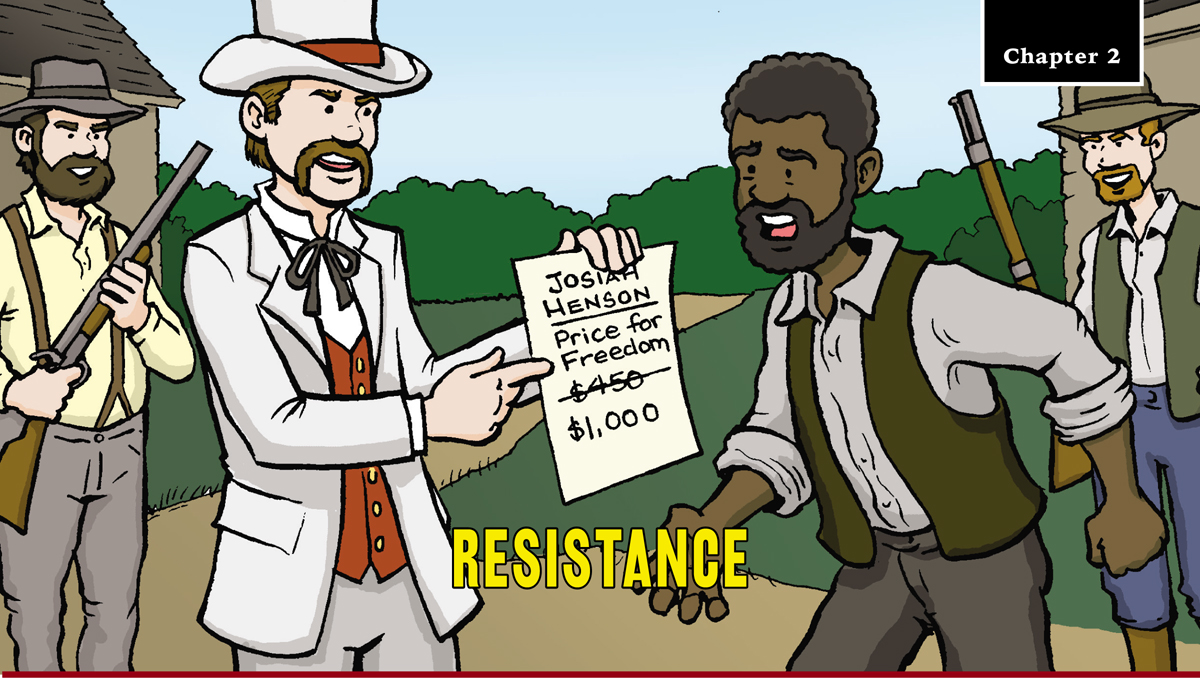
Josiah Henson was Isaac Riley’s prized possession. Strong, athletic, and ambitious, he could “out-hoe, out-reap, out-husk, out-dance…” every other slave. Riley made Henson overseer of his farm. Henson supervised the growing of crops, transported goods to market, and negotiated sales on Riley’s behalf.
Eventually, Henson married an enslaved woman named Charlotte and they had four children. Skilled workers were valuable, and Henson was convinced no harm would ever come to his family. But through the years, Riley fell into debt and needed to hide his slaves from his creditors. Riley ordered Henson to transport 18 slaves, including Henson’s own wife and children, to the farm of Riley’s brother in Kentucky.
ESSENTIAL QUESTION
What are some of the ways different groups of people objected to slavery before the Underground Railroad began?
ambitious: having a strong desire to become successful.
creditor: someone who is owed money.
rations: the food allowance for one day.
eavesdrop: to listen in on someone else’s conversation.
literacy: the ability to read and write.
During the journey, Henson had a chance to escape, but he did not take it.
He wanted freedom, but he believed the only honorable way to get it was to purchase himself. Henson got permission from Riley’s brother to return to Maryland to negotiate for his freedom.
Riley agreed to let Henson buy himself for $450. Henson was short $100, but Riley said Henson could pay the rest of the money when he got it. He put Henson’s freedom certificate in a sealed letter addressed to his brother and told Henson he would get the certificate upon return to Kentucky.
When Riley’s brother opened the letter, Henson discovered he had been betrayed. There was no freedom certificate in the envelope. Instead, Riley had written his brother a note saying the price of Henson’s freedom was $1,000. Henson would remain a slave until he could raise another $650. That would take a lifetime.
DID YOU KNOW?
This website features an exhibit of objects from African American history. Explore the collections of items that relate to the arts, communities, segregation, and slavery. How do the items relate to each other across their points in history? How do the echoes of slavery travel into this century?
National Museum African American History 
Knowing Henson would be enraged at the treachery, Riley had instructed his brother to sell Henson. At that moment, Henson abandoned any idea of honor. As soon as he had the chance, he decided, he would run.
Even before slaves began escaping on the Underground Railroad, people were standing up against the practice of slavery in many different ways. From the moment slavery began in America, enslaved people found ways to resist their bondage.
Some resistance was hard for owners to detect. For example, one day, Jacob Stroyer decided he had been whipped too many times by a cruel overseer. When the man was not looking, Stroyer tied the overseer’s whip to a piece of iron and threw it in the river. Of course, the overseer could just buy another whip, but for a few days, he could not lash his slaves.
Sometimes, if an owner increased the workload too much, slaves slowed their pace, broke tools, or faked illness. If food rations were too skimpy, slaves snuck vegetables from the garden or food from the pantry. The law said no one could teach a slave to read or write, but when the house slave dusted the schoolroom, she might eavesdrop on a white child’s lesson. The slave who worked the docks might steal a book and teach himself to read.
Enslaved people knew literacy was a powerful weapon in their fight for freedom.
Many masters required slaves to attend church services led by pro-slavery preachers. But slaves secretly gathered deep in the woods or met at night to hold their own prayer meetings. They snuck off the plantation to hear traveling ministers preach messages about how God was the real master of everyone, free and slave, black and white. Religious faith gave enslaved people hope. Sometimes, these preachers led slaves to do more than pray.
rebellion: violent resistance to authority.
fanatic: a person who is wildly enthusiastic or obsessed about only one thing.
REVOLT
On a steamy summer night in 1831, a Virginia slave named Nat Turner (1800–1831) launched a bloody rebellion that struck terror into the hearts of slave owners everywhere.
Turner had been deeply religious since childhood. In 1825, he began having visions, which made him believe that God was telling him what to do. Turner began to preach and gained a large following. On August 22, he gave the call to strike.
At 2 a.m., Turner and four other slaves crept into the home of Joseph Travis, Turner’s owner, and killed the entire family, including a baby in a cradle. Then they moved on to other houses. By noon, the army of slaves had grown to 60 armed men. They attacked 15 houses and killed 60 white people before they were stopped.
The backlash from Turner’s Rebellion was swift. Turner was caught and hanged and his corpse was skinned. Across the South, mobs of angry whites attacked any blacks they found. In the town of Murfreesboro, Tennessee, a black man was beheaded for predicting that someday there would be a war between whites and blacks. In Richmond, North Carolina, all free blacks in the city were arrested. More than 200 innocent blacks were killed by whites in the aftermath of Turner’s Rebellion.
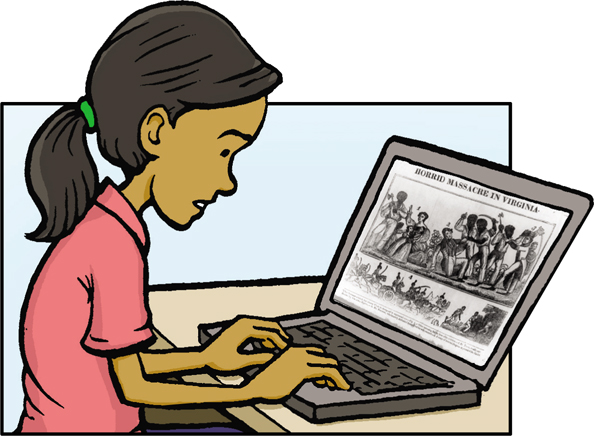
Look at this timeline of the most significant slave rebellions in American history. Do these rebellions have anything in common? Which one came closest to success?
timeline of slave rebellions 
Whites insisted that Turner had been crazy. Only insanity could explain his desire to be free. Slaveholders frequently tried to paint slavery as the natural condition of black people, insisting that slaves would be perfectly content if fanatics such as Turner would stop stirring them up.
After Turner’s Rebellion, the movement of slaves throughout the South was restricted. Owners could no longer voluntarily free their slaves unless the state government approved it. Newly freed slaves had to leave the state at once or face re-enslavement. Any white person who supported efforts to abolish slavery was labeled the enemy.
Turner’s Rebellion was not the first attempted slave revolt, nor was it the last. Violent uprisings by slaves were not common, however, and they all failed. The uprisings do reveal how determined enslaved people were to be free.
Cure For What Ails You
Dr. Samuel Cartwright (1793–1863) of New Orleans developed a theory that the only reason a slave would want to escape was if they were mentally ill. Cartwright called the illness “drapetomania.” The cure for the first attempt to run was food and shelter. The cure for the second attempt was “vigorous whippings.” Why was this a useful diagnosis for slave owners?
equivocate: to conceal your true opinion.
minority: less than half of the population of a country.
revival: when something becomes popular after a long time of not being popular.
ABOLITIONISTS
On January 1, 1831, the people of Boston woke up to discover there was a new newspaper in town—The Liberator. In the first issue, the publisher, William Lloyd Garrison (1805–1879), made it clear that a powerful new voice was on the scene. He warned his readers that his opposition to slavery would be brutally honest. “I am in earnest—I will not equivocate—I will not excuse—I will not retreat a single inch—AND I WILL BE HEARD.” From 1831 through the end of the Civil War in 1865, Garrison published The Liberator every single week for a total of 1,820 issues. He was part of the abolitionist movement.
Determined to destroy slavery, this movement transformed the debate about slavery from a war of words into one of action.
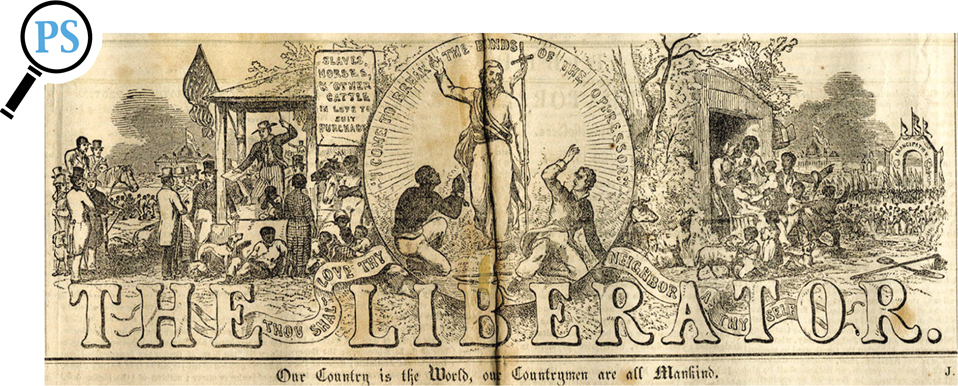
The Liberator (December 15, 1854)
A small minority of people who opposed slavery had always existed in the United States. The strongest and earliest resistance to slavery came from a small Christian sect called the Quakers.
The American Colonization Society was formed in 1816. Members believed slavery should end, but they were afraid that if it ended suddenly, there might be a race war. They thought that if owners gradually and voluntarily freed their slaves and relocated them on another continent, slavery would end peacefully. The organization established a colony on the west coast of Africa. By 1867, more than 13,000 African Americans had relocated to this nation, called Liberia. However, most blacks had no desire to move. They were Americans and wanted to remain free and equal in the United States.
Quaker communities practiced total nonviolence. They considered dancing and music silly and vain. Most importantly, Quakers believed the light of God shone in every person’s soul. No one could own God, therefore, no one should own another human being. By the end of the eighteenth century, Quaker communities across the country had freed their slaves.
In 1775, Quakers formed the nation’s first abolitionist organization—the Pennsylvania Society for Promoting the Abolition of Slavery. By 1800, there were anti-slavery societies in almost every state. As a religious revival spread throughout America in the 1820s, other Christian groups joined antislavery efforts.
Pressure from opponents of slavery led Northern states to abolish slavery or pass gradual emancipation laws. These laws declared that, after a certain date, children born to enslaved mothers were free. But the process of abolishing slavery was slow and varied from state to state. As late as 1860, 18 slaves still lived in New Jersey.
radical: someone who wants major change in social, political, or economic systems.
morally: from the point of view of right and wrong action or good and bad character.
sinfulness: evil.
Frustrated by the slow pace of change, a small group of radical abolitionists emerged in the 1830s. These radicals wanted slavery destroyed quickly and completely. However, abolitionists were a small group and lived scattered about the country. They had no power.
That was soon to change. William Lloyd Garrison, publisher of The Liberator, organized the New England Antislavery Society in 1832. Lewis Tappan (1788–1873) and Arthur Tappan (1786–1865), a pair of wealthy brothers, started a similar group in New York. Garrison believed abolitionists would have greater power if they were united. He organized a national convention to be held in Philadelphia in December 1833.
The city was tense as the delegates arrived. Most Americans thought abolitionists were crazy. Newspapers described them as dangerous fanatics.
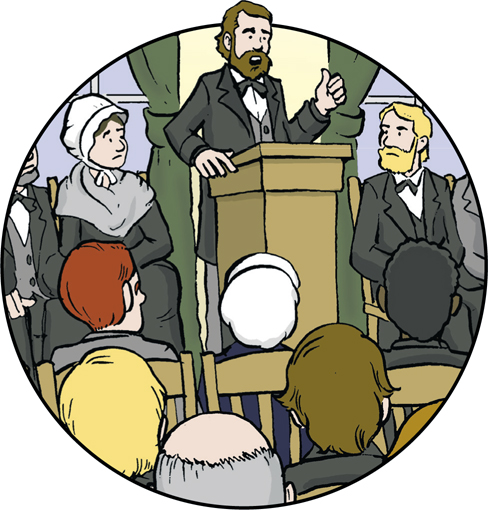
The police warned the convention leaders that they would not guarantee the delegates’ safety, but the delegates still came.
The people who attended the convention all came from Northern states. Most were young, male, and white, and many were Quakers. There were a handful of free blacks in the group and a few women. The delegates met for three days straight, not even breaking for meals. When hungry, they nibbled on crackers and drank water.
The delegates formed a new national organization—the American Antislavery Society. The mission statement of this society formed the principles that inspired workers on the Underground Railroad. It challenged people to take direct action to end slavery, but rejected violence. Instead, the society believed slavery could be overcome by making owners see that slavery was morally wrong. The convention adjourned with the pledge to found anti-slavery societies in “every city, town, and village.”
Hundreds of anti-slavery societies were created across Northern communities. Dozens of anti-slavery newspapers were established. Thousands of pamphlets were passed out. In 1835, abolitionists flooded the mailboxes of slaveholders with warnings to repent their evil ways. Abolitionists launched the Great Petition Campaign in 1836 and sent a wave of citizen requests to Congress demanding an end to slavery. In 1838, Congress received so many petitions they filled a 20-by-30-foot room from floor to ceiling.
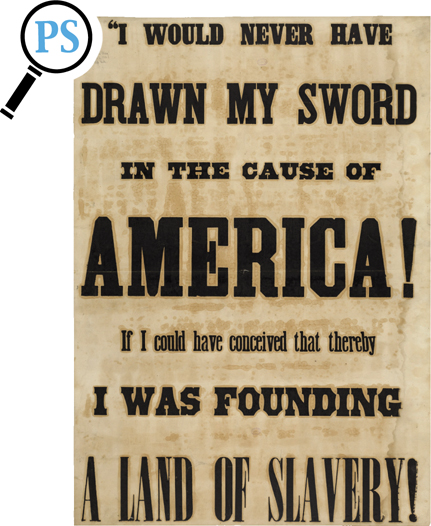
A poster from the anti-slavery movement
Traveling agents did the grunt work of the abolitionist movement. Many of these men were preachers. They traveled for months on end, speaking about the sinfulness of slavery. Their work helped convince people in rural areas of the North to oppose slavery. The agents raised money and got petitions signed. By 1837, there were more than 100,000 members of the American Antislavery Society and more than 1,000 local abolitionist organizations spread across the Northern states.
hostility: great anger or strong dislike.
tarred and feathered: a form of mob punishment where pine tar, a thick, sticky substance, is heated and poured over a person, after which the individual is covered in feathers.
ransack: to search for something in a way that messes up or damages the place being searched.
gag rule: a law that prevents people from talking about a specific subject.
convert: to change.
urgency: needing immediate attention.
Hostility greeted abolitionists wherever they went. In slave states, mobs attacked post offices and burned all abolitionist pamphlets. White Southerners suspected of abolitionist views were harassed, arrested, and even tarred and feathered.
Northern audiences were no more welcoming. In Hartford, Connecticut, the First Congregational Church, where anti-slavery meetings were held, was burned. In Cincinnati, Ohio, law enforcement stood by as white mobs burned black neighborhoods. Elijah Lovejoy, a white editor of an anti-slavery publication in Alton, Illinois, was shot to death as he tried to defend his office from being ransacked by an angry mob.
The national government was no help. In 1836, Congress passed a gag rule prohibiting the discussion of all abolitionist petitions before the House of Representatives. By the end of the 1830s, abolitionists realized that the American public, the law, and the government were on the side of slavery. Something had to change.
AFRICAN AMERICAN LEADERS STIR THINGS UP
Black abolitionists who had escaped slavery grew impatient with the slow pace of freedom. Frederick Douglass, Henry Highland Garnett (1815–1882), and Sojourner Truth (1797–1883) used their personal stories to persuade people to support a more aggressive approach to freeing slaves.
Even though politics was considered a man’s game in nineteenth-century America, Lucretia Mott (1793-1880) and a handful of other women attended the anti-slavery convention in Philadelphia in 1833. Mott even addressed the audience. Following the convention, Mott founded the Philadelphia Female Anti-Slavery Society. This all-female, interracial organization existed until 1870.
Frederick Douglass could move an audience from outrage to tears. The first time he stepped in front of a podium, Douglass trembled with nerves, but he wanted to tell his story. He was born on a Maryland plantation in 1818 and escaped in 1838. He told his audiences about being so hungry when he was a child that he fought the dog for table scraps. People wept as Douglass described the time he witnessed his aunt stripped to the waist, tied to a beam, and whipped until her back was shredded.
Other former slaves took their stories on the road. Some listeners were converted to abolitionism, while others threw rotten eggs or stones. The testimony of these former slaves brought energy and urgency to the abolitionist movement. By the 1840s, white leaders were ready to start acting to help slaves. Their timing was perfect. A system was already developing to do just that—the Underground Railroad.
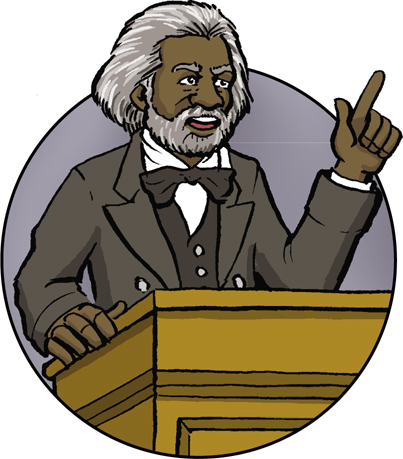
ESSENTIAL QUESTION
Now it’s time to consider and discuss the Essential Question: What are some of the ways different groups of people objected to slavery before the Underground Railroad began?
WHO GOES THERE?
Owners could hire out their slaves to work for someone else. Some hired-out slaves were required to be licensed and to wear an identification tag at all times. The medallions were small copper squares, between 1½ and 3 inches square, worn around the neck on a string or chain. The badges were engraved with a few simple words, including the city where the slave lived, an identification number, job title, and the year.
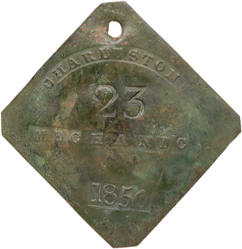
Slave badge (Collection of the Smithsonian National Museum of African American History and Culture)
Look at this slave badge. Historians are left with a mystery. Who was the person who wore this badge? Did he have a family? Did he ever get his freedom? What were his hopes and dreams? What were his nightmares? If you had to wear an ID tag that would communicate who you are to the future, what would that tag say?
Make your own identity tag using a similar method as the slave badges, but reveal more about who you are as a person. What key words reveal who you are? Here are two examples of personal badges.
Jon Hanson
*Older brother
*Shortstop
*Dreamer
Esme Garcia
*Mexican American
*Cat lover
*Skateboarder
DID YOU KNOW?
The importation of slaves into the United States was banned after 1808. Take a look at the animated map on this website. What do you see happening after 1808? Was the law against importing slaves enforced?
slave voyages database animated map 
EXPLORE MORE: How do people react when they read your ID? Do they see you the way you see yourself? Ask your friends what four descriptors they would use to describe you. Do you agree with their descriptions of you?
BROADCAST YOUR VIEWS ON A BROADSIDE
Broadsides were posters that could have both words and pictures. They were the main source of information in the days before radio, television, and the Internet. During the time of slavery, broadsides were displayed in courthouses or post office buildings, hung in shop windows, and handed out on the street. In this activity, you will make your own broadside.
Take a look at this broadside.
*What can you tell about who produced this broadside?
*What does this broadside want people to do?
*How do the authors of this broadside feel about slavery and abolitionists?
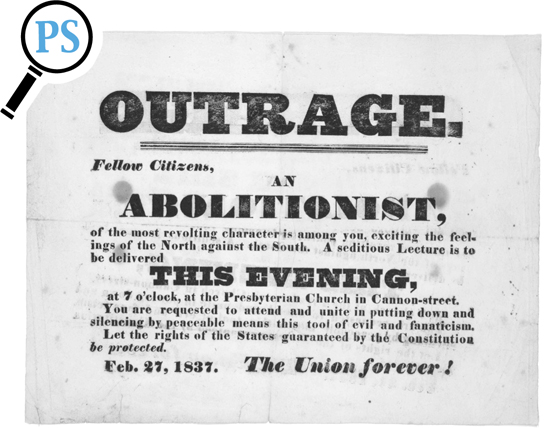
(Rare Book and Special Collections Division, Library of Congress)
If you could abolish anything in the world, what would it be? Draw your own broadside to persuade people to agree with you on this issue.
EXPLORE MORE: Historic broadsides were displayed on paper. You live in an electronic age and have more choices available to you. Create a digital broadside. What form will it take? How will you distribute it? Are there advantages and disadvantages to digital publishing? What are the advantages and disadvantages of paper broadsides?
WORDS TO KNOW
broadside: an advertisement or public notice printed on a large piece of paper and displayed for public viewing.